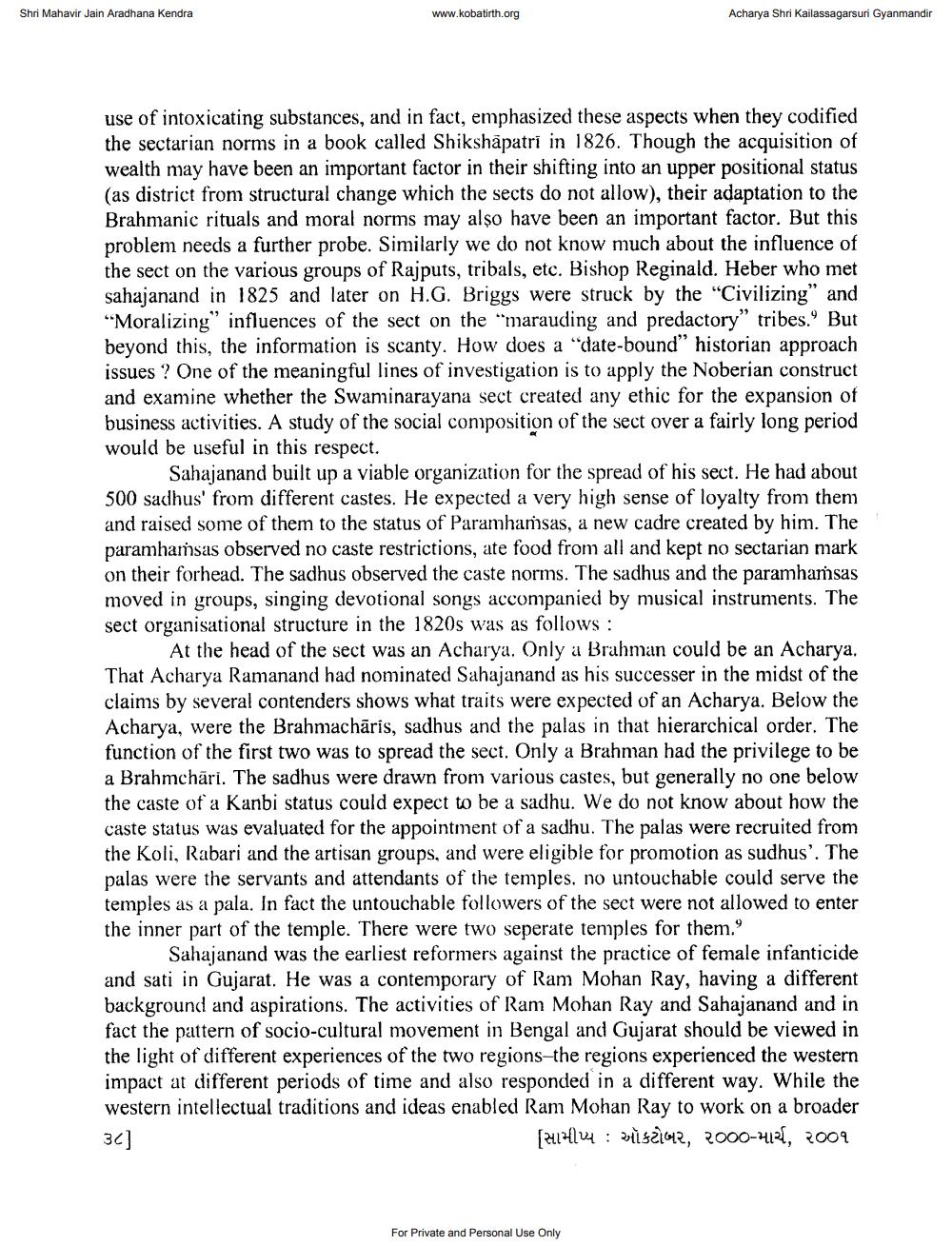________________
Shri Mahavir Jain Aradhana Kendra
www.kobatirth.org
Acharya Shri Kailassagarsuri Gyanmandir
use of intoxicating substances, and in fact, emphasized these aspects when they codified the sectarian norms in a book called Shikshāpatri in 1826. Though the acquisition of wealth may have been an important factor in their shifting into an upper positional status (as district from structural change which the sects do not allow), their adaptation to the Brahmanic rituals and moral norms may also have been an important factor. But this problem needs a further probe. Similarly we do not know much about the influence of the sect on the various groups of Rajputs, tribals, etc. Bishop Reginald. Heber who met sahajanand in 1825 and later on H.G. Briggs were struck by the "Civilizing” and "Moralizing" influences of the sect on the marauding and predactory" tribes. But beyond this, the information is scanty. How does a "date-bound" historian approach issues ? One of the meaningful lines of investigation is to apply the Noberian construct and examine whether the Swaminarayana sect created any ethic for the expansion of business activities. A study of the social composition of the sect over a fairly long period would be useful in this respect.
Sahajanand built up a viable organization for the spread of his sect. He had about 500 sadhus' from different castes. He expected a very high sense of loyalty from them and raised some of them to the status of Paramhamsas, a new cadre created by him. The paramhamsas observed no caste restrictions, ate food from all and kept no sectarian mark on their forhead. The sadhus observed the caste norms. The sadhus and the paramhamsas moved in groups, singing devotional songs accompanied by musical instruments. The sect organisational structure in the 1820s was as follows:
At the head of the sect was an Acharya. Only a Brahman could be an Acharya. That Acharya Ramanand had nominated Sahajanand as his successer in the midst of the claims by several contenders shows what traits were expected of an Acharya. Below the Acharya, were the Brahmachāris, sadhus and the palas in that hierarchical order. The function of the first two was to spread the sect. Only a Brahman had the privilege to be a Brahmchāri. The sadhus were drawn from various castes, but generally no one below the caste of a Kanbi status could expect to be a sadhu. We do not know about how the caste status was evaluated for the appointment of a sadhu. The palas were recruited from the Koli, Rabari and the artisan groups, and were eligible for promotion as sudhus'. The palas were the servants and attendants of the temples, no untouchable could serve the temples as a pala. In fact the untouchable followers of the sect were not allowed to enter the inner part of the temple. There were two seperate temples for them.
Sahajanand was the earliest reformers against the practice of female infanticide and sati in Gujarat. He was a contemporary of Ram Mohan Ray, having a different background and aspirations. The activities of Ram Mohan Ray and Sahajanand and in fact the pattern of socio-cultural movement in Bengal and Gujarat should be viewed in the light of different experiences of the two regions-the regions experienced the western impact at different periods of time and also responded in a different way. While the western intellectual traditions and ideas enabled Ram Mohan Ray to work on a broader
[244lu4 : Puli$21642, 2000-7421, 2004
3C]
For Private and Personal Use Only




